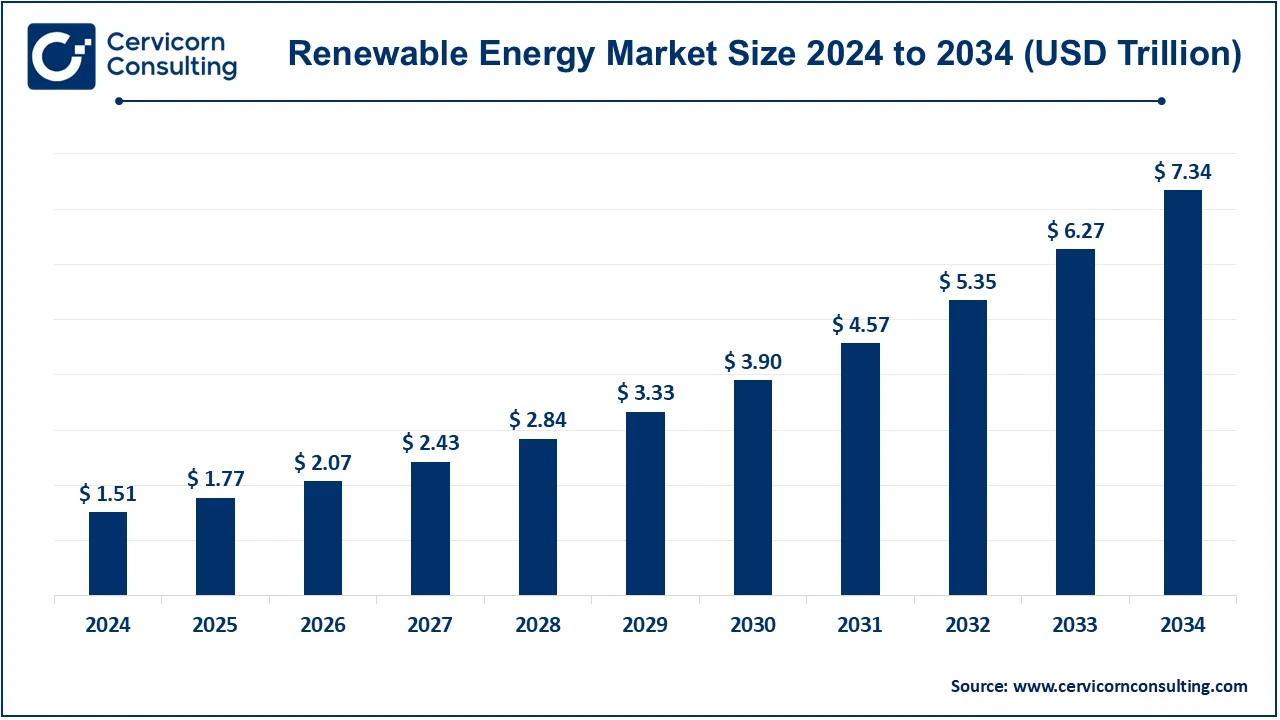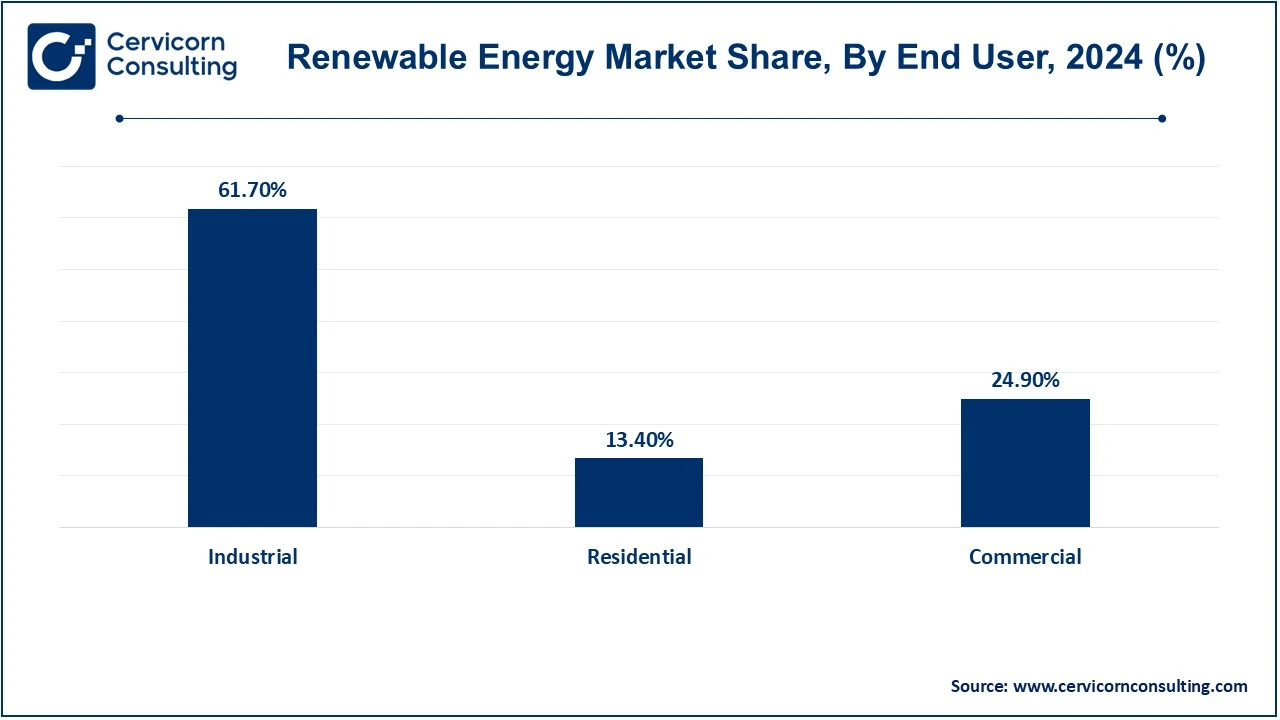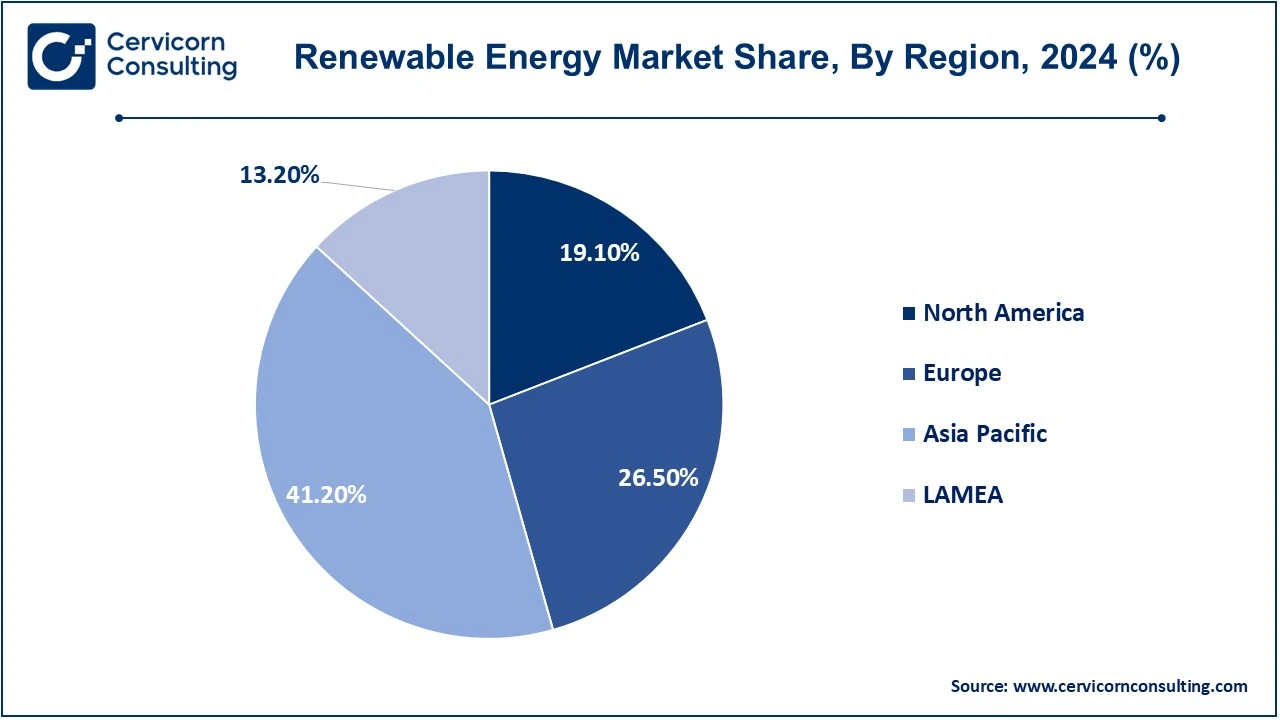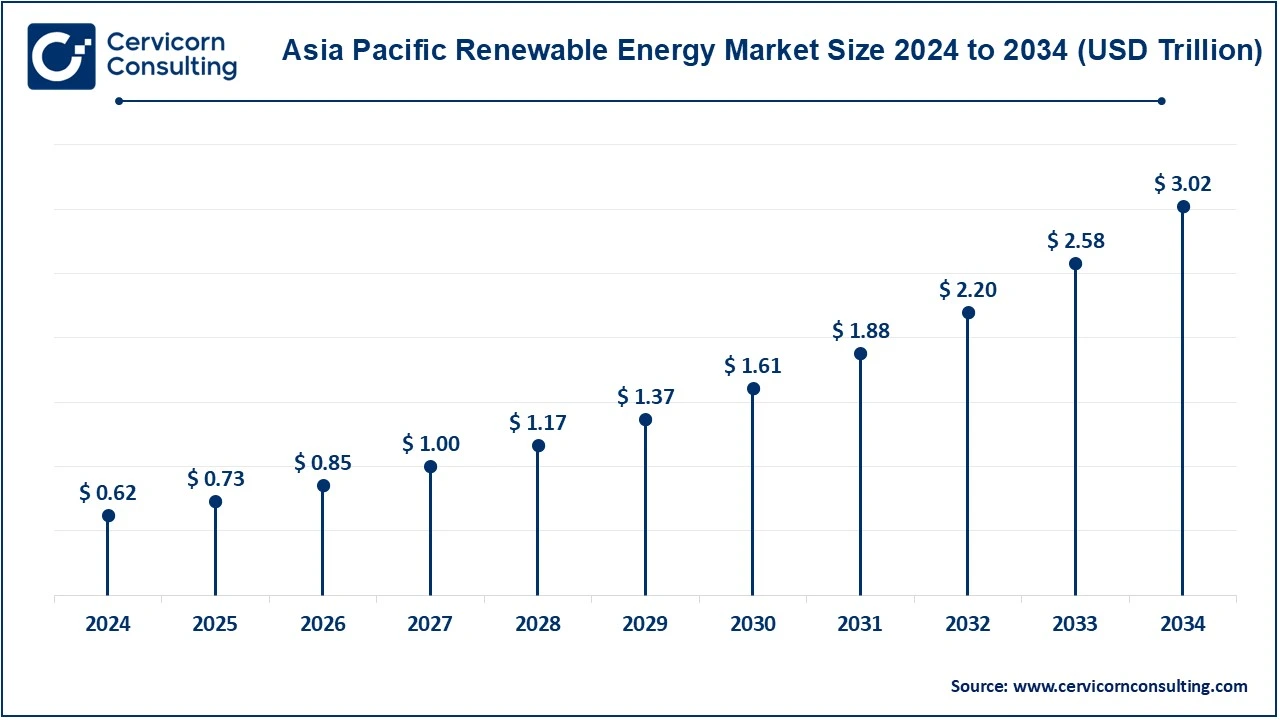Renewable Energy Market Size and Growth 2025 to 2034
The global renewable energy market size was valued at USD 1.51 trillion in 2024 and is projected to hit around USD 7.34 trillion by 2034, growing at a compound annual growth rate (CAGR) of 17.13% over the forecast period 2025 to 2034.
The renewable energy market is thriving, driven mainly by increases in global demands for a cleaner source of energy; the technological gains made lately, as well as positive moves from governments; decarbonization of countries toward climate change, investments in hydroelectric and solar and wind power offering cleaner alternatives to fossil fuels. More so, innovations in energy storage and improvements in integrating it into the grid enhance these systems even more in terms of efficiency and reliability. Electrification in the transportation industry and manufacturing sectors is accelerating and increasing the demand for renewable power. The influence and push from the public as well as the private sector enhance widespread usage while further accelerating the growth process for this market.

Report Highlights
- The Asia Pacific has dominated the market and accounted revenue share of 41.20% in 2024.
- The Europe has captured revenue share of 26.50% in 2024.
- By product, the solar power has contributed revenue share of 30.82% in 2024.
- By end user, the industrial segment has held revenue share of 61.70% in 2024.
- By end user, the commercial segments is expected to witness fastest growth during the forecast period.
Renewable Energy Market Growth Factors
- Government Support and Subsidies: The governments around the world are offering attractive incentives in terms of tax credits, grants, and subsidies to switch to renewable sources of energy. This reduces high capital costs on consumers and businesses, thereby making the transition to clean energy relatively cheaper. Beneficial regulations, such as renewable energy targets, will be able to generate an investment-friendly environment and thus promote growth in the market and a shift towards a green economy.
- Costs falling in Renewable Technologies: For many decades, the cost of renewable technologies such as solar and wind energy has decreased significantly, bringing them closer to equality in competing with fossil fuels. Most economies have seen a reduction in production costs due to technological and economies of scale improvements or developments, making it more convenient for residential and commercial clients, which has expanded the size of the market.
- Global Contracts and Obligations: Global agreements such as the Paris Agreement play a critical role in pushing countries to adopt renewable energy. Agreements that set ambitious carbon reduction targets encourage countries to invest more in clean energy projects. International cooperation in climate policy further expands markets because countries share technologies, funding, and expertise in efforts to meet their climate goals and reduce global emissions.
Renewable Energy Market Trends
- Decentralization in Energy Production: The third trend emerging in the energy sector is decentralization: local, decentralized production, using sunlight through solar panels or wind and small hydropower plants. This kind of local, decentralized production enables persons, communities, and businesses to have their clean energy supply so that there is less of a dependence on central power plants. This can increase energy resilience and, above all, energy autonomy in remote or underserved areas.
- Electrification of Transportation: This new trend of electrification in transport is going along well with the growth of renewable energy. The more electric cars take center stage, the cleaner electricity is demanded, which means renewable sources of energy have to be adopted. It decreases the carbon emissions of the transport sector and fast tracks a sustainable energy system since, in this regard, it allows the use of solar or wind energy to power an EV.
- Artificial Intelligence and IoT in Energy: Artificial Intelligence (AI) and the Internet of Things (IoT) are transforming the renewable energy market by optimizing energy production, consumption, and distribution. These technologies make possible smart grids, which would be able to integrate many renewable energy sources more efficiently. It also enhances the performance of renewable energy systems like solar panels and wind turbines because it predicts when the energy is needed or when it needs maintenance to result in efficiency and reliability.
Report Scope
| Area of Focus |
Details |
| Market Size in 2025 |
USD 1.77 Trillion |
| Expected Market Size in 2034 |
USD 7.34 Trillion |
| Projected CAGR 2025 to 2034 |
17.13% |
| Leading Region |
Asia-Pacific |
| Significant Growth |
North America |
| Key Segments |
Product, End User, Region |
| Key Companies |
ABB, Siemens Gamesa Renewable Energy, S.A., Schneider Electric, Xcel Energy Inc., EDF, National Grid Renewables, Acciona, Enel Spa, Innergex, The Tata Power Company Limited, General Electric, Suzlon Energy Ltd., Invenergy |
Renewable Energy Market Dynamics
Drivers
- Private Investment and Funding: Another factor that is driving the renewable energy market is private investment. Increasing venture capital, private equity, and infrastructure investors funding has facilitated speedy technological as well as project development of renewable energies. There has been rising investor confidence regarding long-term profitability and sustainability in renewable sources, thus private financing has played an important role in scaling up clean energy solutions across the globe.
- Public-Private Partnerships: Public-private partnerships are successfully bridging the funding gap that exists in renewable energy projects. Governments are partnering with private companies to offer funding and regulatory support as well as infrastructure in large-scale renewable projects. This has enabled easier deployment, and access to new technologies, and also helps overcome financial and logistical barriers hindering the growth of renewable energy.
- Dependency reduction from fossil fuels: Adaptation to renewable energy will grow globally with emphasis upon reduced dependence on fossil fuel because renewables are readily substitutable since its alternative has depleted and environmental impact for the first time would stand in the way for fossils. The transition to a diversified fuel source portfolio, thereby also diversifying greenhouse gas emissions, reinforces the positive aspects of enhanced security by moving to cleaner sources; more important, the push increases demand for renewables.
Restraints
- High Initial Investment Costs: Though renewable technologies are becoming cheaper by the day, the initial installation cost for renewable energy systems is still quite high for mega projects. This cost primarily involves equipment, infrastructure, and installation that may pose a challenge to both consumers and businesses, especially in the developing world with limited access to much capital. Therefore, this financial barrier acts as a barrier to the widespread implementation of renewable energy.
- Challenges to Renewable Energy in Transmission Infrastructure: Renewable energy sources like wind and solar energy have its primary source locations far away from cities that are having the most demand. Adequate transmission infrastructure for this transportation may not be able to support larger-scale utilization of renewable energy. New strong grid infrastructure should be designed so that integration of renewable energy in the energy mix and has credible channels of distribution.
- Environmental and Ecological Impact: Renewable energy is cleaner while the largest installations in the wind farms as well as the largest solar setups have environment and ecological implications greatly. Their building and operation tend to alter the local ecological systems and also affect some wildlife habitat areas or a lot of area. The issues shall, however, be overcome by prudent planning and taking adequate environmental measures to mitigate those impacts.
Opportunities
- Electric Cars and Charging Stations: Growing electric vehicles needs provide a considerable space of renewable energy. Powerful solar and wind, that provides renewable sources for energy for efficient charging infrastructure, shall facilitate low carbon emissions by means of transportation and unlock a further market for clean energy alternatives and solutions: residential as well as public stations with advanced grid management solutions which include the proper, secure as well as prompt supplying process of energy towards an Electric Vehicle.
- Microgrids and Distributed Energy Systems: Microgrids are a small-scale, localized energy system that can be operated independently or in conjunction with the main grid. They connect renewable energy sources like solar and wind with energy storage, so they are ideal for isolated locations or regions prone to power outages. Microgrids offer resilience in energy supply, sustainability, and cost-effectiveness. It will allow communities to minimize reliance on central power infrastructure, enhance energy security, and reduce carbon footprint.
- Green Finance and Renewable Investment: Investment in projects that provide renewable energy is among the world's fastest-growing markets under the category of green finance. This increases financial products of green bonds and sustainable funds, especially for institutional investors, and sometimes even governments. This is important because large-scale renewable projects are critical in the shift into clean energy, in which wind farms, installation of solar systems, the development of storage solutions, and other innovative new renewals play a huge role in these processes.
Challenges
- Land acquisition and permitting: Acquiring lands for major renewable energy projects is not very easy, particularly when it comes to the cases of solar and wind farms. Finding a right kind of land to install on land, zoning issues, and seeking permission may cause delays. In high density or sparse space places, the fight over the land and resistance by locals can halt the installation of renewables.
- Supply Chain Constraints: The renewable energy business is raw material-based. Therefore, rare earth metals constitute a high percentage in wind turbines and photovoltaic panels. Fluctuating pricing and manufacturing longer lead times are some effects of political tensions and stringent environmental regulations, which give birth to such global supply chain uncertainty. However, an effective stable supply chain will be a prerequisite for the further expansion of the renewable energy markets.
- Unpredictable Weather Conditions: A critical problem of renewable energy production, especially by the sources like solar and wind, is the variability in output they provide. Changes of season or weather, and even regional climatic conditions, cause much variability in energy production. Such variations make very difficult to deliver a consistent power supply. Energy storage is added in combination with this renewable energy in order to level out such production disparities.
Renewable Energy Market Segmental Analysis
the renewable energy market is segmented into product, end user and region. Based on product, the market is classified into hydropower, wind power, solar power, bioenergy, geothermal energy, and ocean energy. Based on end user, the market is classified into industrial, residential, and commercial.
Product Analysis
Solar Power: The solar power is dominating segment in 2024. It involves converting sunlight into electricity by using photovoltaic (PV) cells on rooftops or through huge solar farms. Concentrated solar power (CSP) systems produce power by concentrating sunlight to heat a medium which produces steam to run the turbines. Solar power is available in abundant supply and it is a renewable source, especially in sunny areas. It can be applied to both centralized generations, with solar farms, and decentralized generation, through residential and commercial solar installations, reducing significantly the environmental impact and decreasing reliance on traditional power supplies.
Hydropower: Hydroelectricity is produced by using flowing water energy. Large-scale power plants like dams and reservoirs with hydropower are controlling the flow of water for producing a large amount of electricity. Small-scale hydropower systems, micro as well as pico power plants, provide local or isolated power supply for rural and distant areas. Hydropower is flexible to meet the base-load electricity demand and support the grid stability. The pumped-storage hydropower is also covered, which stores energy during periods of low demand and releases it during peak demand times to add reliability to the grid.
Wind Power: Wind power is generated through turbines that transform kinetic energy from the wind into electrical energy. There are onshore wind farms, which are typically placed on land, and offshore wind farms, which harness stronger, more consistent winds at sea. Offshore wind projects cost more to install but will offer greater capacity and energy. As such, wind power forms an important growth segment of the renewable energy sector and contributes toward energy diversification efforts with its scalable potential toward less reliance on fossil fuel usage and decreased greenhouse gas emissions.
Bioenergy: Bioenergy is made from organic sources such as plants, wood, agricultural waste, and even algae that have been processed into producing either heat, electricity, or biofuels. Biomass energy is essentially the combustion of organic matter to generate power, whereas biogas, which results from anaerobic digestion of organic wastes, can be used either for electricity or heating purposes. Biofuels, such as ethanol and biodiesel, are made from crops and waste materials, serving as renewable alternatives to gasoline and diesel. This segment plays a key role in reducing carbon emissions and supporting energy security by utilizing waste materials.
End User Analysis
Industrial: The industrial segment is dominating segment in 2024. Renewable sources are used to power huge industrial processes, heavy-duty machinery, and production lines in the industrial sector. The operational cost is greatly reduced and the carbon footprint comes down by using solar, wind, or biomass energy sources by industries. Renewable sources can be generated on-site with solar installation or small turbines wind or purchased through the PPA from the energy service provider. Increasingly regulatory incentives, the need to be energy independent, as well as growing environmental sustainability goals, are driving industries to adopt clean energy.

Residential: This is a source where households are using renewable energy sources to generate electricity. More common technology applied is using solar panels; however, it is pretty common among families to have rooftop systems with clean electricity and reduce household bills on energy consumption. The other option includes small turbines or in-home energy storage. Government incentives and rebates, coupled with consumer interest in sustainable energy, assist in the incorporation of renewable energy into residential applications. In this category, consumers are made more energy-independent as part of the grander scheme of reducing their dependency on the grid.
Commercial: The commercial sector refers to businesses, offices, and retail properties using renewable power sources. Commercial companies tend to invest in solar energy sources for both economic and environmental reasons, especially when power prices become too high. Many of them also use wind power or biomass energy, with some through direct generation and others through PPAs with renewable suppliers. The motivation of the commercial sector beyond cost savings in energy is through corporate sustainability goals, such as LEED green building certifications. The sector has a high contribution towards the widespread penetration of clean energy technologies.
Renewable Energy Market Regional Analysis
The renewable energy market is segmented into several key regions: North America, Europe, Asia-Pacific, and LAMEA (Latin America, Middle East, and Africa). Here’s an in-depth look at each region.
North America performing significant growth in renewable energy market
The North America renewable energy market size was valued at USD 0.29 trillion in 2024 and is expected to reach around USD 1.40 trillion by 2034. The U.S. remains the biggest leader in wind and solar energy to make the power sector greener and decarbonize the power sector. For instance, last year, according to data issued by the U.S. Energy Information Administration, for example, in 2023, January 2024, the U.S. electric power sector produced a total of 4,017 billion kWh of electricity; renewables—wind, solar, hydro, biomass, and geothermal—accounted for 22% of that output, or 874 billion kWh. Renewable power generation surpassed nuclear for the first time since 2021 and coal for the first time since 2022. Canada is a significant power generator in hydroelectricity and also ranks among the world's top producers of renewable energy. Mexico has recently become active on the world solar and wind energy scene by formulating government policies that can positively aid renewable energy uptake in this area. The regional diversities and resources bring high chances of increasing renewables in the future years.
Europe renewable energy market is performing remarkably
The Europe renewable energy market size was estimated at USD 0.40 trillion in 2024 and is projected to surpass around USD 1.95 trillion by 2034. Europe leads the best-performing prime regions; the largest four countries involved are Germany, the UK, France, and Spain. This region is known to be the world leader in the development of wind and solar power and to be very strict in climate policies, most importantly, through its "Energiewende”. The UK focuses on offshore wind, making tremendous progress in carbon emissions reductions. For instance, in the UK, Sofia already gave about £760 million in economic value. This incorporates employment that is local and also includes investing in the necessary infrastructures. It presents the vital example of renewable energy and underlines their role and importance in supporting regional sustainability and community development as the nuclear power base of France begins gradually introducing solar and wind energy into their systems. High growth rates were recorded for solar and wind power not only in the southern regions like the climate encourages, in Spain.

What makes the Asia-Pacific region the largest and fastest-growing market for renewable energy?
The Asia-Pacific renewable energy market size was accounted for USD 0.62 trillion in 2024 and is forecasted to grow around USD 3.02 trillion by 2034. Asia-Pacific is the largest and fastest-growing in the world, dominated by China, Japan, India, and South Korea. China leads globally in solar and wind capacity backed by government support and large-scale renewable projects.In India, solar power has grown at a rapid growth trajectory and is aiming at very ambitious renewable energy targets. Japan is prioritizing more solar and offshore wind expansion. South Korea is prioritizing green hydrogen and energy storage. These are massive potential pools for expanding renewable energy sources given the region's large populations and expanding economies.

LAMEA Renewable Energy Market Growth
The LAMEA renewable energy market was valued at USD 1.20 trillion in 2024 and is anticipated to reach around USD 0.97 trillion by 2034. The LAMEA region consists of Latin America, the Middle East, and Africa. It is becoming very open to renewable energy sources. Latin America is also prominent, with Brazil showing huge bioenergy resources and several hydroelectric power projects. Countries in the Middle East, including the UAE and Saudi Arabia, are investing heavily in solar power as part of diversification away from oil. Africa, with plenty of solar and wind power resources, plans to spend more in the renewable energy sector to increase energy supply in the face of ever-growing energy demand and the resultant energy poverty. Investments in the region's clean energy are huge and have room for more growth.
Renewable Energy Market Top Companies
CEO Statements
Morten Wierod, CEO of ABB
- "The transition to renewable energy is not just a necessity; it is an opportunity to reshape the global energy landscape. ABB is committed to advancing the energy transition with innovative technologies that help integrate, distribute, and manage clean energy more efficiently. Our solutions empower utilities, industries, and cities to accelerate their sustainability goals while ensuring reliability and resilience in an increasingly electrified world."
Bob Frenzel CEO of Xcel Energy Inc.,
- "At Xcel Energy, we are committed to leading the transition to a clean energy future. Our renewable energy investments are not just good for the planet—they’re also good for our customers and the communities we serve. By advancing wind, solar, and energy storage solutions, we are building a sustainable, low-carbon energy grid that will power the economy of tomorrow while ensuring a cleaner, more resilient energy future for generations to come."
Blake Nixon, CEO of National Grid Renewables
- "As the renewable energy market continues to evolve, we are witnessing a critical shift toward sustainable and resilient energy systems. At National Grid Renewables, our focus remains on accelerating the transition to a clean energy future by driving innovation, expanding our renewable portfolio, and partnering with communities to ensure that clean, affordable power is accessible to all. We believe that through strategic investments in wind, solar, and energy storage, we can help build a low-carbon grid that not only meets the demands of today but also secures a sustainable and prosperous tomorrow."
Recent Developments
Recent strategic initiatives and acquisitions in the renewable energy industry indicate a strong trend toward innovation and strategic collaboration between the industry's major players. The key firms ABB, Xcel Energy Inc., EDF, National Grid Renewables, Acciona, and Enel Spa have built up their technological strength by creating new high-performance energy storage systems, smart grids, and integrated platforms of renewable generation. These innovations aim to develop efficiency, reliability, and the ability to scale within systems of renewable energy while helping accelerate that transition toward a low-carbon economy. Joint ventures and other partnerships will work toward this, and it will lead to such a company developing its position as one of the leaders in the global transition to renewable energy with implications on all the sustainability goals as well as energy security
- In February 2024, GE Vernova's Grid Solutions business won multi-million-dollar orders from Power Grid Corporation of India (PGCIL) to upgrade electricity transmission in India by enhancing its renewable energy integration efforts.765 kV Shunt Reactors from this order will be manufactured at GE T&D India's Vadodara plant.The company promises to deliver the order in 2025-26, thus supporting India in realizing the country's sustainable energy transition and commitment under the National policy of making 50 percent of electricity capacity generation come from non-fossil sources by 2030.
- In September 2024, Xcel Energy shared very significant developments in the company's clean energy efforts with the public. The goal for this was to reach zero-carbon net emissions by the year 2050. Finally, it would significantly invest in renewable sources of power such as wind and sun. Additionally, the firm would implement increased energy efficiency practices. It would close some coal-powered plants and build electric vehicles. Xcel Energy will continue to pursue sustainable practices and reduce greenhouse gas emissions. This whole process focuses on Xcel as leading the way toward a clean energy future.
- In November 2024, ACCIONA Energía also strengthened its growth in the United States with the acquisition of the two wind farms, Green Pastures I and II, in Texas, for a total amount of USD 202.5 million. Together, the two farms will output at an installed capacity of 150 MW per farm annually around 1.1 TWh of renewable energy. The investment took ACCIONA's installed capacity in the U.S. to a total of 2.8 GW and strengthened the company's commitment to the transition into energy. The projects connected with the ERCOT grid; increasing, thereby, its presence within one of the key markets concerning renewable energy integration.
Market Segmentation
By Product
- Hydropower
- Wind Power
- Solar Power
- Bioenergy
- Geothermal Energy
- Ocean Energy
By End User
- Industrial
- Residential
- Commercial
By Region
- North America
- APAC
- Europe
- LAMEA
...
...



